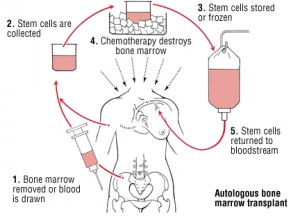A bone marrow transplant is when special cells (called stem cells) that are normally found in the bone marrow are taken out, filtered, and given back either to the same person or to another person.
Why Is It Done?

In diseases such as leukemia and aplastic anemia, the bone marrow is unhealthy. The purpose of a bone marrow transplant is to replace unhealthy stem cells with healthy ones. This can treat or even cure the disease.
Two Types of Bone Marrow Transplants
- Autologous bone marrow transplant – The donor is the person him/herself.
- Allogenic bone marrow transplant – The donor is another person whose tissue has the same genetic type as the person needing the transplant (recipient). Because tissue types are inherited, similar to hair or eye color, it is more likely that the recipient will find a suitable donor in a brother or sister. This, however, happens only 25 to 30 percent of the time.
What the Donor Experiences
In most cases, a donation is made using circulating stem cells (PBSC) collected by apheresis. First, the donor receives injections for a few days of a medication that causes stem cells to move out of the bone marrow and into the blood. For the stem cell collection, the donor is connected to a machine by a needle inserted in the vein (like for blood donation). Blood is taken from the vein, filtered by the machine to collect the stem cells, and then returned back to the donor through a needle in the other arm. There is almost no need for a recovery time with this procedure.
If stem cells are collected by bone marrow harvest (much less likely), the donor will go to the operating room and while asleep under anesthesia, a needle will be inserted into either the hip or the breastbone to take out some bone marrow. After awakening, he/she may feel some pain where the needle was inserted.
What the Recipient Experiences
A bone marrow transplant is a difficult procedure to go through. Usually the person receives high doses of chemotherapy and/or radiation to eliminate whatever bone marrow he/she has left to make room for the new marrow transplant. Once this is done, the new stem cells are put into the person intravenously, similar to a blood transfusion. The stem cells then find their way to the bone and start to grow and produce more cells (called engraftment).
Serious problems can occur during the time that the bone marrow is gone or very low. Infections are common, as is anemia, and low platelets in the blood can cause dangerous bleeding internally. Recipients often receive blood transfusions to treat these problems while they are waiting for the new stem cells to start growing.
Bone Marrow Transplant at SafeMedTrip affiliated World Class Hospitals in India
A successful bone marrow transplant requires an expert medical team – doctors, nurses, and other support staff – who are experienced in bone marrow transplants, can promptly recognize problems and emerging side effects, and know how to react swiftly and properly if problems do arise.
A good bone marrow transplant program will also recognize the importance of providing patients and their families with emotional and psychological support before, during and after the transplant, and will make personal and other support systemsreadily available to families for this purpose. All this is and more is provided at our affiliate hospitals. We make this difficult journey easy for the patient and his relatives.
To know more about Bone Marrow Transplant (BMT) in India please visit this link : https://safemedtrip.com/medical-services/organ-transplant-in-india/bone-marrow-transplant-in-india.html

 Click to WhatsApp
Click to WhatsApp +91-9899993637
+91-9899993637



